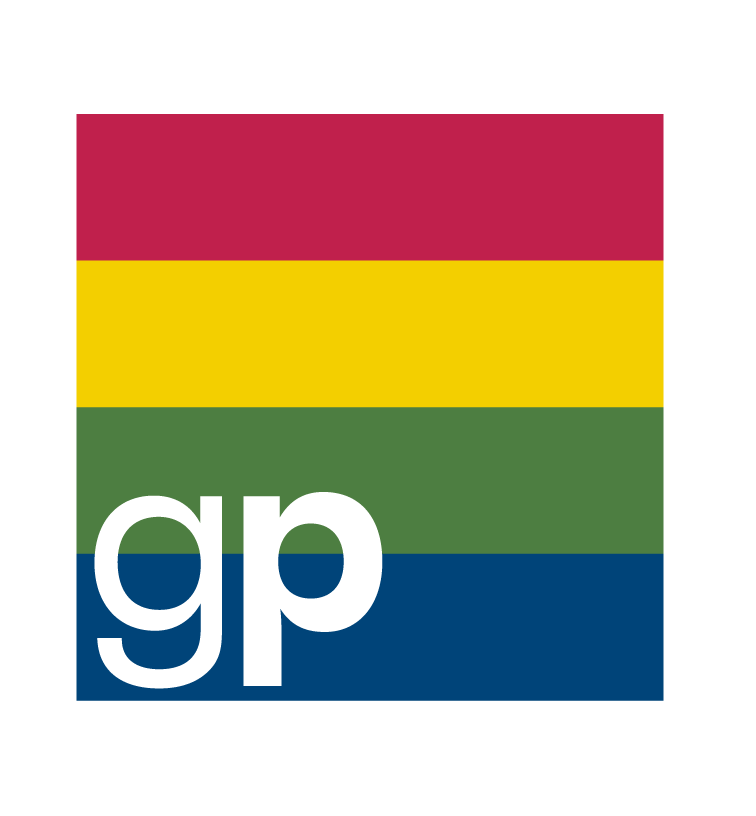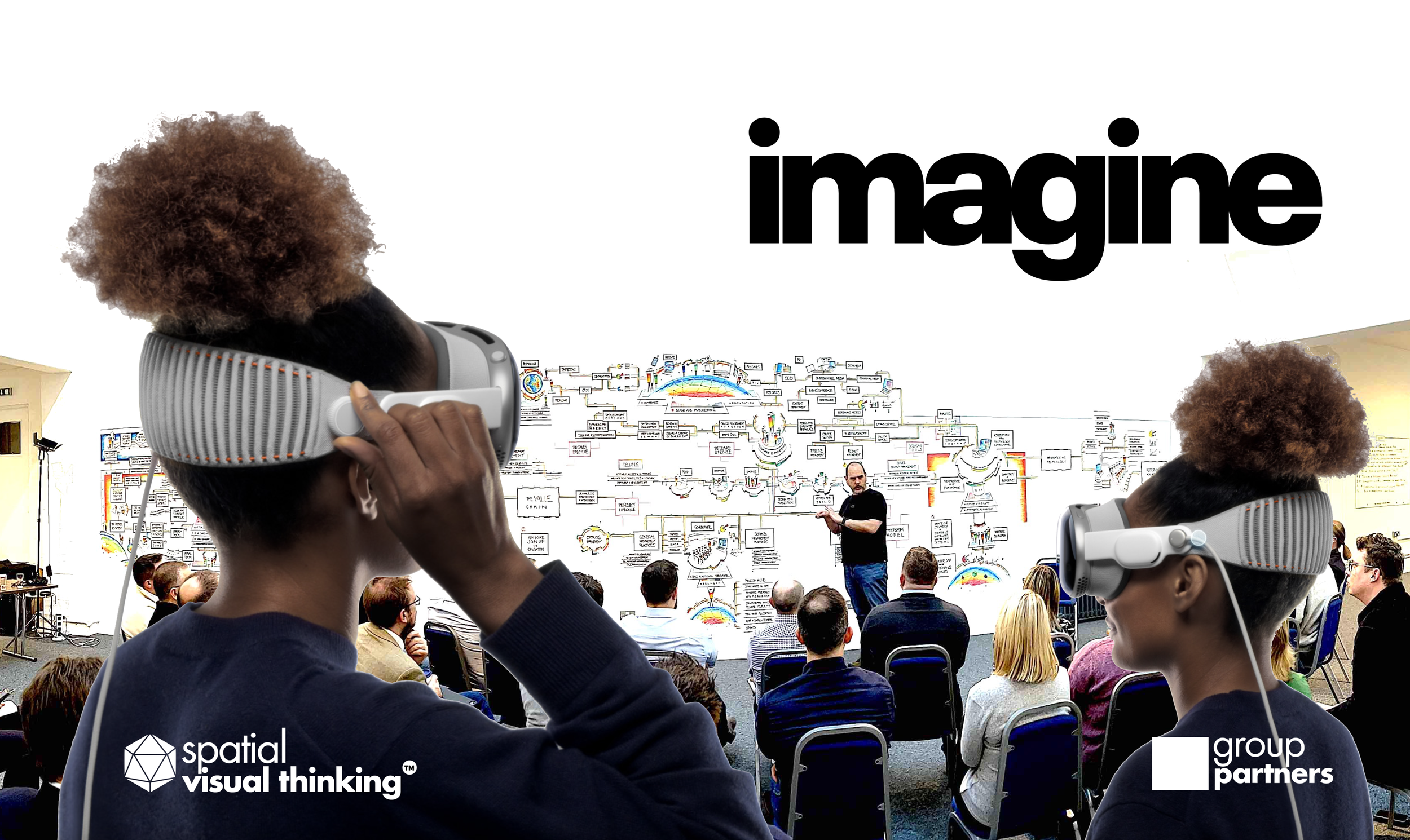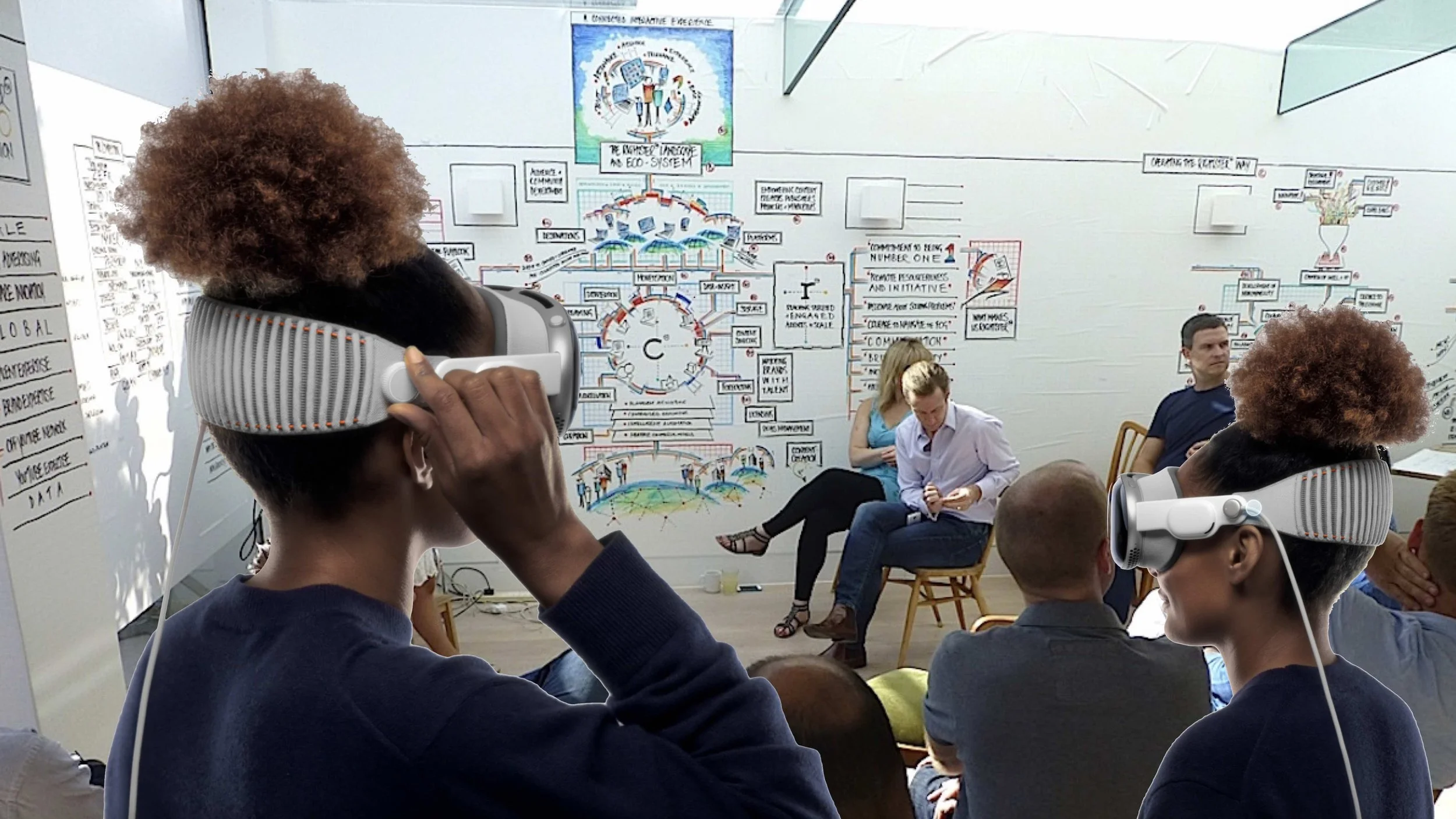
Spatial Visual Thinking™
Creating Strategy And Collaboration Through Mixed Reality
The draft project brief for third-year students of the University of Greenwich
A ‘spatial’ computing application that exploits the new advantages of MR. The advent of Apple Pro brings about this vision. As yet unlaunched, our imaginations are fired up by the potential.
We envision an interactive experience that extends collaboration at scale but retains the intimacy we can create based on two decades of experience with our Structured Visual Thinking™ methodology.
Applying Structured Visual Thinking™
Structured Visual Thinking™ (SVT™) is a facilitated methodology for professional-level collaborative strategy and visioning. Helping leadership teams to shape their own destinies.
The team participants (facilitated part of the process) engage in a sequenced dialogue while a visual practitioner captures key ideas on a 100-foot white wall. This large-scale visualisation enables the team to synthesise insights across modules.
For The Students,
Through this project, you will gain practical experience of what facilitation of business leadership teams using Structured Visual Thinking™ sessions entails.
You will learn how the methodology guides a team to co-create a visualised strategic plan or vision for a company.
You will envision a groundbreaking new frontier in this field that allows teams to apply this technique to accelerate their strategic, creative, transformational and planning activities at scale and globally for dispersed teams.
The Audience For The Application:
Strategic consulting and change practice is a multi-billion dollar industry. Leaders and decision-making teams need to have space to think and conceptualise. This creates a mission-critical outcome - allowing genuine understanding and confidence by directly strategising their businesses' future or exploiting challenges/opportunities.
Senior decision-makers and direct stakeholders in the future or plans for businesses of all shapes, industries and sizes. Globally.
Context For The Brief: Visit the website.
Interact with the Chat Application (ChatGP) to better understand how the methodology works.
Structured Visual Thinking™ is a proven methodology for teams to engage through expertly facilitated conversations in a logical and intuitive sequence.
A qualified practitioner facilitates each module/conversation; simultaneously, a visualised interpretation is drawn on a large (100-foot white wall).
Because it’s live and honours the answers of the facilitated conversations with the team, the result is massive ownership, understanding, appreciation, engagement, and motivation to take this ‘blueprint/framework’ into execution.
The application of this technique is vast. Creating change, transformation, developing strategies, and business cases, building new stories and narratives, launching new products, developing brands, solving challenges, communicating visions, developing better cultures and leadership teams, and aligning disparate aspects of the business.
Applications of this technique have been proven in every industry sector. Applied in social, government, ESG and many other areas. In small, medium and large enterprises as well as improving the individual's own appreciation of the system of business and their future. The approach changes mindsets.
Structured Visual Thinking™ offers all attendees a chance to think critically and systemically, be inspired and motivated, and experiment with the art of the possible within a safe and creative space.
Until now (Apple Pro, for example), tools like video-conferencing and MIRO (Digital whiteboards) have been helpful. Still, they have yet to properly immerse the remote audiences in how live audiences can physically and emotionally attach to live facilitation and visualisation. The intimacy and human connection, senses and human energy/engagement are lost. There is no immersion in the unfolding journey.
Only now, while the core venue/location will still be in the flesh and in the real sense, those collaborating remotely will remain massively disadvantaged and unconnected because they only have video conferencing, and they find it challenging to engage throughout such events.
Project Brief: Creating Immersive Professional Engagement Experiences
This project invites you to explore the potential of using immersive technologies to facilitate engagement and immersion into visually facilitated conversations transcribed in real-time on large white walls.
Aim: To design an original interactive experience. One that guides users into the value, meaning and results of collaboration in mixed reality. To enable globally located collaborators in a way that makes them feel present in the same room as a physical and live session.
Consider how visuals, sound, mechanics and tactile elements would work together to create an absorbing and integrated world within which enhanced thinking occurs.
Aim to make the experience intimate enough to hear and see the interaction with the team's discussions. In particular, drawing the emerging blueprint/framework on the walls.
Consider the potential for further innovation - for example - biofeedback or spatial computing to enhance the experience for collaborators.
The key will be to fuse digital interactivity with human exchange through facilitated conversation.
Shape an experience that speaks to seasoned leaders and newcomers with an equal appreciation of what is emerging through collaboration.
Approach:
Understand the world of Structured Visual Thinking™ and how it works. Immerse yourself in research through examples of similar applications of VR/AR, but particularly imagine what’s coming with MR and (for example) the forthcoming Apple Pro.
Be ambitious with what’s possible but pragmatic with technology and interactions because of overwhelm and the natural complexity of the topics. (Strategy Development, Business Change and Planning) although SVT™ is typically applied over two or three days and to senior business leaders, it also works at a small scale with entrepreneurs and small start-ups in short sprints.
Craft an experience that will inspire.
Design something that you yourself would enjoy and benefit from.
Learning Outcomes:
Students will:
Understand the principles and format of a proven business transformation and strategy development methodology like Structured Visual Thinking™
Gain experience with technology that underpins human collaboration on a practical level and apply the experience globally.
Understand considerations in designing experiences that exploit mixed realities, allowing both real-world immersion and human-scale intimacy with the team at a distance. Using audio, kinesthetic and visual techniques unparalleled previously
Improve 3D modelling, animation, sound design and programming skills to augment the current capabilities of pure ‘real world’ limitations. (Fly-in pre-existing models or create models on the fly)
Explore connecting external/remote interfaces and biosensors to track human engagement and attachment to the sequence of events and provide (digital twin style) opportunities for self-experimentation.
Improve research, and create new frontiers of immersive experiential collaboration ideation and the synthesis abilities required at a strategic systems level
Develop project management and scoping skills by working within limitations as set by the scope and success criteria of the project.
Build teamwork and communication skills (if working in groups) and presentation skills as an outcome of describing the solution.
Learn to create professional documentation and articulate concepts immensely applicable to the real world of business and the enterprise—infinite applications across all industries.
Success Criteria:
An original app that creates a sense of intimate collaboration as experts facilitate Structured Visual Thinking™ in mixed reality.
An app that genuinely enables collaborative engagement with the visualisation created by the visualiser using spatial computing and MR interfaces and might integrate further innovation in 3D models and other valuable applications/techniques.
Remote teams and those present in the core venue can effectively contribute to the Structured Visual Thinking modules together at a distance while feeling intimately connected.
The visual development on the walls and the face-to-face conversations are collaborative within a shared virtual space for all to view and interact meaningfully.
Interactions feel intuitive for participants to contribute ideas
The app provides clear guidance on leading sessions for any new facilitators
Visualisations are seen as coherently organised to reflect structured thinking
Everyone involved can gain energy/ownership in the creative process using the app
Documentation conveys the workflow of the design decisions and development insights
Students demonstrate learning around MR tech, visualization, and collaboration
The resulting app concept is innovative and aligns to SVT™ methodology
Project Deliverables:
A meaningful application
Concept proposal
Technical documentation
User testing results
Project reflection
Well articulated result
Optional:
Promotional assets (trailer, screenshots, branding)
Publishable build package
Project Timeline:
Week 1: Research and ideation
Week 2-3: Prototyping core interaction and visual approach
Week 4-5: Implementation of graphics, sound and UX flow
Week 6-7: External interface integration, testing and iteration
Week 8: Final polish, documentation and submissions
Project Assessment Criteria:
Submissions will be assessed on:
Professional coherence of the core concept
Technical execution and robustness
Visual experience appeal and polish
Intuitiveness and elegance of user experience
Adherence to brief requirements
Quality of process documentation







